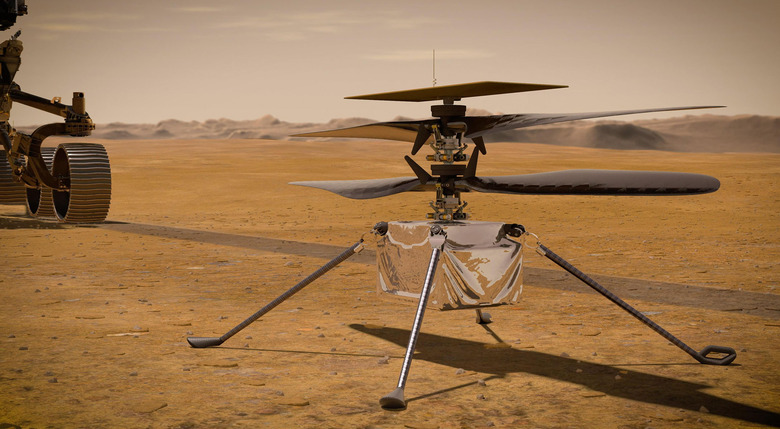NASA's Mars Helicopter Is Exceeding Expectations In Every Way
NASA's Mars helicopter has already completed four flights on the Red Planet. According to the Ingenuity team, it's completed everything it needs to in order to be considered a success, but it's not done yet. In fact, the limits that NASA thought it would have to deal with during the helicopter's testing don't appear to be that big of a deal anymore, and that's great news for the scientists that want to push the helicopter to its absolute limits.
In a new blog post on NASA's Mars science website, Josh Ravich of the Ingenuity team at NASA's Jet Propulsion Laboratory reveals the group's feelings about the helicopter's performance thus far. To put it simply, the helicopter has totally crushed it, and the tiny chopper appears to be dealing with all of the hazards of the Martian surface easily. The group had feared that the helicopter might suffer breakdowns early on, but that never happened, and it's performing so well that the Ingenuity team is pivoting to a longer testing timeline.
It's actually pretty wild that the helicopter is performing as well as it is. The chopper was built by NASA but it features a number of "off the shelf" parts that weren't designed for Mars. Despite that, the helicopter has stood up well and successfully completed the tasks that its handlers have set forth for it.
"Our helicopter is even more robust than we had hoped," Ravich explains. "The power system that we fretted over for years is providing more than enough energy to keep our heaters going at night and to fly during the day. The off-the-shelf components for our guidance and navigation systems are also doing great, as is our rotor system. You name it, and it's doing just fine or better."
The helicopter's fifth flight will be, in many ways, its most important so far. It will fly farther than it ever has and it won't be returning back to its initial landing zone. Instead, it will travel toward a new "airfield" to continue its testing while also remaining within sight of the Perseverance rover.
"We are traveling to a new base because this is the direction Perseverance is going, and if we want to continue to demonstrate what can be done from an aerial perspective, we have to go where the rover goes," Ravich said.
NASA will continue to push the limits of the helicopter and conduct test flights while they gather more and more data about its flights on Mars. Knowing that Mars didn't completely destroy the helicopter's more sensitive components after it was released by the rover is great news for NASA going forward, and could open the door to more advanced aerial machines to be sent to Mars in the near future.
